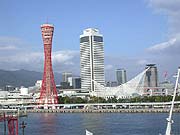 |
| Kobe port view |
Kobe - home of one of the world's leading international trading ports - is a truly inviting1 city, noted2 for its beauty and thriving urban environment, superbly enhanced by the backdrop(背景)of verdant(长满绿色植物的)Mount Rokko.
Kobe has prospered3 from times of old as the hub of Japan's maritime4 activities. As far back as the 8th century it had a port, then called the Owada Anchorage, now known as Wadamisaki. It became a key place for both land and sea trade and, by the end of the 13th century, had come to be known as the Port of Hyogo. In 1868, Kobe opened itself to the outside world and began to write its own history as one of Japan's first five major ports opened to trade with the West.
In 1868, Kobe had a population of 134,000, which swelled5 to one million by 1939, making it one of the six major cities in Japan. Over the years, the port grew in size and importance, and industry flourished. Then came the Second World War, bringing widespread and unprecedented6 devastation7 to Kobe. By the time hostilities8 ended, the population had dwindled9 to a mere10 380,000. Today, Kobe has a population of 1.5 million.
Kobe's downtown area contains districts that retain the atmosphere of those exotic bygone days. Prime examples include what is known as the Old Foreign Settlement, Nankin-machi (Chinatown) and Kitano, famous for its old western-style houses built by early foreign residents and known as Ijinkan.
 |
| Kobe Wing Stadium, a new 42,000 capacity football stadium, was so named to conjure11 up the image of wings, rising from the reconstruction12 after the 1995 earthquake. |
Kobe is easily accessible by land, sea and air. It is approximately 3 hours and 20 minutes from Tokyo by Shinkansen train. Kobe, together with Osaka and Kyoto, forms the economic focal point of Kansai (关西), western Japan.
The town of Nara is famous nationwide for sake (日本酒) brewing13, while Mount Rokko and Arima Hot Spring are popular resorts easily accessible from the city centre. A mere 30-minute drive westward14 from the city centre takes you to the Tarumi-Maiko Coast, which commands superb views of the scenic15 Suma Beach and the Akashi Kaikyo Bridge (total length: 3,911 meters), the world's longest suspension bridge.
Although Kobe was seriously damaged by the Great Hanshin-Awaji Earthquake of 17 January 1995, restoration has progressed rapidly. In remembrance of that catastrophic event, the Kobe Port Earthquake Memorial Park, as well as other facilities, has been erected16.
|
 收听单词发音
收听单词发音 
